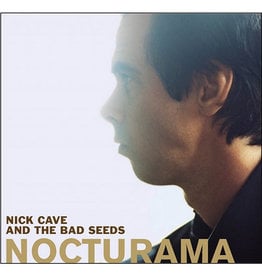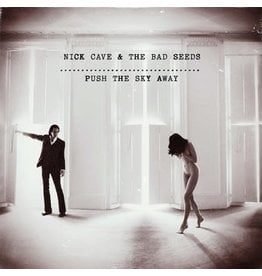Cave, Nick & The Bad Seeds: Tender Prey LP
| Availability: | In stock |
"The period leading up to and culminating in the making of Nick Cave & the Bad Seeds’ fifth studio album, Tender Prey, was a profusely fertile time for all the individual band members, overloaded with so much peripheral creative activity and personal turmoil that the entire long process of recording and mixing the album was encompassed by tumult.
"Inaugural recording for Tender Prey took place on 7th September 1987; the last remaining mixes were completed on 14th March 1988...Cave was deep into his novel at the flat he shared with Die Haut bassist Christoph Dreher on Dresdener Strasse in Berlin’s Kreuzberg district, when the embryonic form of what would become “The Mercy Seat” first came to him. Scribbling on an open pad next to his typewriter, Cave wrestled with the lyrics over the next several months, the epic literary sprawl of his novel subtly seeping into the song as he labored over them both simultaneously.
“The Mercy Seat,” Cave recollects, “…felt like something that I was writing in the way that I would write a novel, as opposed to writing a song.” Thomas Wydler remembers Nick “worked his ass off,” but at that particular point he simply wasn’t applying himself to songwriting. Focused primarily on his novel, Nick recalls that the song that would in time come to be recognized as one of his signature compositions “…just kind of leaked through the cracks.”
"When the opportunity to commence recording of Nick’s slowly wrought opus finally presented itself, The Bad Seeds chose to return to the familiar grounds of Hansa Studios, the pride of their adopted hometown of Berlin, the same studio where they had recorded Your Funeral…My Trial and The Firstborn Is Dead. The grand main recording room at Hansa, with its superb acoustics, was originally a Nazi ballroom, and the control room had served as a sauna for a while; but by the time The Bad Seeds began working there, it was already regarded as a studio of prodigious importance. Irrespective of that, Hansa was a natural choice for the band: in addition to being comparatively less expensive than roughly equivalent English studios, the laissez-passer security policy suited their lifestyles. “At that time, the Hansa studio was an open gate, 24 hours.” Wydler remembers. “People came in, speed freaks came in, friends came in, dealers came in. Everybody came in!”
"...Aside from “The Mercy Seat,” Nick did not have many lyrics ready to go when the band entered Hansa to begin basic tracking for the songs that would eventually comprise Tender Prey. According to Mick Harvey, in those days it was not unusual for Nick to do a lot of writing in the studio itself. “On the early albums he would come in and he wouldn’t have many sets of lyrics, actually. He’d sometimes be in the back room scribbling away.”
"With Cave caught up in the writing of And The Ass Saw the Angel for so long, it is hardly surprising that he entered the Tender Prey sessions armed with almost no words. Uncharacteristically however, Nick did bring aboard a lot of instrumental passages he had composed on the piano at Dreher’s flat. “What was surprising,” asserts Mick, “was that he had so many pieces of instrumental music that he’d written. It was a bit of a new thing: he’d written all these piano tunes. It’s quite strange actually. I can’t remember him ever having done that before (or since). I’m not sure where that all came from, especially these long pieces like ‘Slowly Goes the Night’; it was very unusual for Nick.”
"Although Nick had lyrics ready to go for “The Mercy Seat”, the song had not yet fully taken shape. Nick attests that he sat down in the studio piano and devised a descending chord structure and “…that I was able to sing the words to those chords. Then Mick threw in the E minor – B flat vamp.” However, rather than starting with the piano, recording of the basic tracks for “The Mercy Seat” actually began with a loop which Mick says “came out of the same idea that Nick had been trying to do for ages: he wanted to have a song that was really relentlessly at you and in your face.” Nick affirms he was aiming for an aggressive rapid-fire machine-like effect similar to the churning rhythm of “Harlem” by Suicide, “...but we didn’t know how to do that, so we did it with drumsticks on the open tuning of the bass.”
"Other songs from the original Hansa sessions include “Slowly Goes the Night,” “Up Jumped the Devil,” “Sugar, Sugar, Sugar,” “City of Refuge” and “Lucy.” Basic tracks were undertaken for a variety of things, but as Mick recalls “There were a lot of instrumentals recorded in those original sessions that just didn’t get used.”
"As accommodating as Hansa could be, the band was not to be afforded the luxury of hunkering down there. Hectic schedules, conflicting commitments and untold distractions forced the band to continue work on the album haphazardly in a bewildering array of studios around the world. “The album came together in a very piecemeal way,” affirms Mick. “I remember recording ‘Deanna’ in London in Konk studios. Work on ‘The Mercy Seat’ — like piano, strings, vocals, and organ — was done in Trident II down in Pimlico. I remember doing mixes of ‘The Mercy Seat’ and working on ‘Sunday’s Slave’ at The Strongroom. We were just all over the shop.”
"In keeping with the band’s unpredictable trajectory in the construction of Tender Prey, and somewhat contrary to normal studio procedure, Thomas remembers that at one of the final sessions in Australia, he was still overdubbing drums as one of the last remaining components to be added to “Watching Alice.” In that single session detail lies a hint of at least one of the reasons for the different feel of the Nick Cave & The Bad Seeds early recordings: the manner in which songs were often pieced together overdub by overdub – as opposed to being captured mostly live by the whole band in one go (the preferred practice on all their albums since Henry’s Dream).
"The multi-track layering method frequently employed by Nick Cave & the Bad Seeds on their first five studio albums was used to fit songs together piece by piece, constructing them out of fragments and tentative ideas until a cohesive composition gradually appeared. Compared to a more conventional multi-tracking approach where overdubs are layered over a predetermined groove and a rigid structure, early Bad Seeds recording methods sometimes appear to have been conducted almost as an aleatoric hunt for a song. Thomas asserts, “You hear from The Good Son on, the music started to get more normal in a way, and before it was quite strange. I like the old days, this experimental stuff. It was the right way to play this strange blues music.”
"Nick concurs, “...There was a sense of journeying and adventure that went on within the studio. Because I was coming into the studio with not that much, for me there was always a feeling of ‘Are we going to be able to make a record?’ The idea of going into the studio with 13 songs or whatever (which is what I do now) was unheard of back then.”
"If the song “Watching Alice” typifies a Bad Seeds methodology of recording and arranging, by the same token, from Nick’s point of view that particular song was the progenitor of an idea of a new lyrical device, one which Nick broadly describes as “being very much a voyeuristic thing.” The passive narrative framework “of just sitting and watching stuff” (which the protagonist in “Watching Alice” does quite explicitly) proved to be a point of departure he would pursue and elaborate later on.
"Moreover, Nick believes that though Tender Prey, as an album, was “kind of scattershot,” as with its four predecessors, it “gave birth” to and suggested manifold possibilities. “I think some of our later records are probably better records, in the sense that they’re played better, some of the songs are more fully realized,” explains Cave, “but they feel to me in a lot of ways like closed entities. Maybe that’s being unfair, but the earlier records are all suggesting ways forward. There’s a questing feeling about some of them.”
"Ultimately, some of Tender Prey album was mixed in London, most of it was mixed in Melbourne, but throughout the entire convoluted process, Tony Cohen was deep in the thick of it. Early on in the recording sessions, Thomas remembers The Bad Seeds’ guiding hand had been prone to disappearing under the console in the middle of sessions. “We were looking for him and then I looked under the mixing desk and he was there sleeping. He made a little tent.” Tony often opted to camp out at Hansa, closer to the action.
"“There were a lot of drugs involved in the whole mess too,” contends Mick, a further complicating factor in the logistics of finishing the album. “It was just really hard to get it all focused and it came out as a really big unwieldy bunch of songs.” Kid too remembers Tender Prey “...took a long time, in many cities and it was kind of a dark period in people’s lives...and mine.”
"If Tender Prey is an album searching for something in a lot of different dark places, literally and figuratively, it is unclear if it actually found what it was looking for. Nick admits, “There was a huge amount of chaos around the making of some of these records. Tender Prey was very much like that - and not only in the way the songs were put together. There’s a real seat of your pants type feel to everything, which is wonderful about the early Bad Seeds records.” - James Sclavunos






